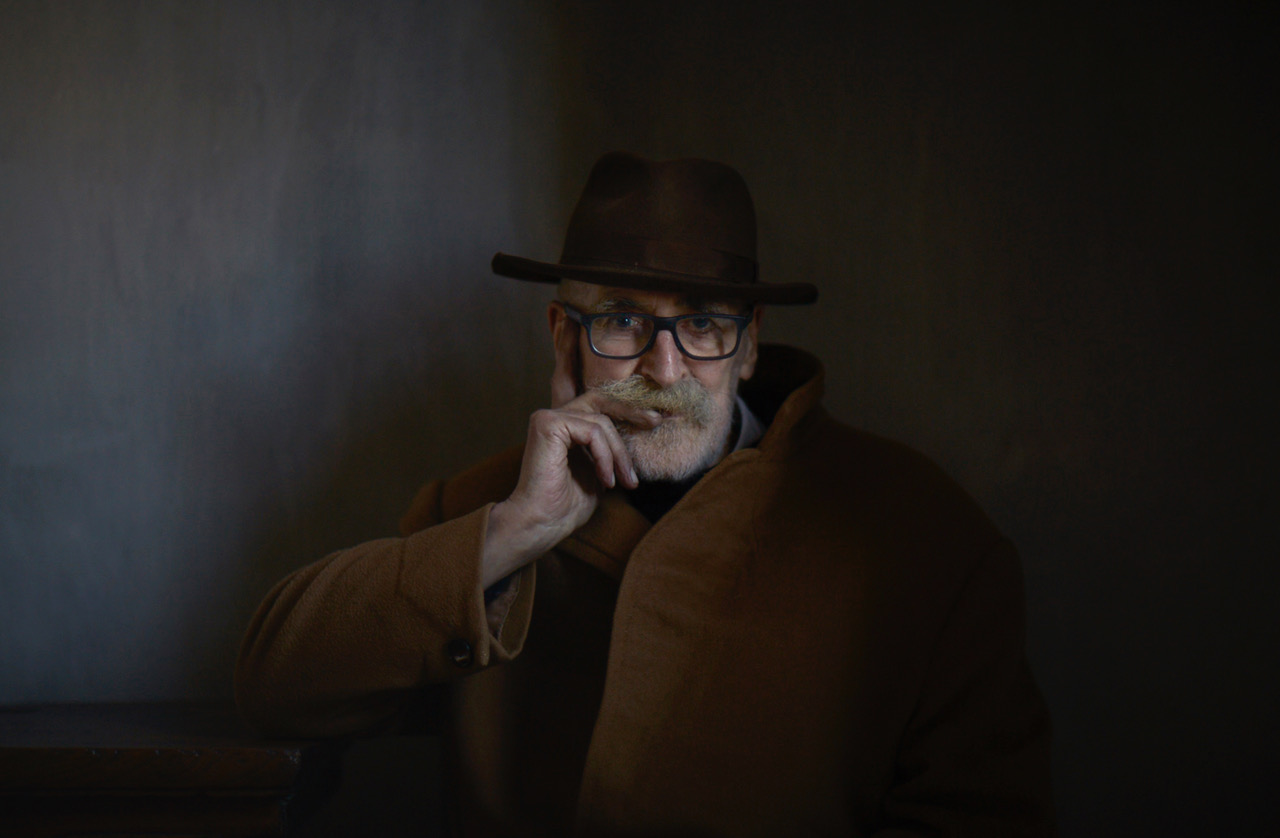Scottish artist, author, actor, painter, printmaker, playwright, screenwriter, writer, stage designer, and dad, has died aged 83. The heartfelt outpouring of affection has been phenomenal. Yes, he was a National Treasure; he was charming, witty and KIND. Everyone loved him.
Byrne was born in Paisley’s Ferguslie Park into a Catholic working-class family. He attended Glasgow Art School, 1958-63. Before art school, he worked as a “slab boy” at the local Stoddard’s carpet factory, mixing paint. He mined this plus his Teddy Boy youth, with its rock and roll, mods, rockers and punks for imagery and inspiration for the rest of his life, immortalising Britain’s original teen subculture.
I first saw John Byrne in 1977 rehearsing his first play, ‘Writer’s Cramp’ in Glasgow Print Studio’s Ingram Street gallery space. I began writing about him in 1983 with his Edinburgh Festival Fringe exhibition at the Traverse Theatre. It was, I concluded, “sheer pleasure” and came complete with “a huge fibreglass harpy perched on the roof” plus detailed sketches of earrings and new designs for the Royal Court.” By 1985, I had bought Byrne’s framed costume design for McQuin’s Metamorphosis at the Traverse.
Soon, this Paisley boy became an international icon, a Renaissance man. “I like a lot of irons in the fire, many strings to my bow,” he always said. He made his name with his famous play ‘Slab Boys” and cult TV series’ Tutti Frutti’ and ‘Your Cheatin Heart’. Twenty-five years before, he was also well known as ‘Patrick’, his nom de plume for a concocted grandad whose naive work sold like hotcakes. The hoax didn’t last long; he soon came clean!
But 30 years ago, things were not plain sailing for this workaholic. Financial frustrations were rife. “I don’t have a brand image,” he told me in 1994. “I like to do different things. Nobody wants to be a one-trick pony, but it’s commercially advantageous. The public prefers sameness. I must be the one artist whose prices have de-escalated. I’m getting fed up with scraping by.” Despite Broadway hits, even film & theatre disappointed. “I have a love/hate relationship with film. Commerce and art are mutually exclusive. That’s a marriage made in hell.”
We were sitting at a cafe in the Kings Road round the corner from the Chelsea Arts Club, my habitual London base. John and his partner, Tilda Swinton, lived nearby. Sleepless nights he compounded John’s negative mood. He had a 5 pm deadline for his C4 film script and one of his 80-a-day cigarettes in hand. It’s a typical Chelsea Bohemian scene, apart from the pram.
Baby twins Honor and Xavier were, he said, “all-consuming. It’s non-stop for Tilda and me. It’s beautiful and marvellous, so rewarding – but I’ve had to find a new way of working. I used to hammer away 14 hours at a stretch. Not now. I’m not one for walking, but we take them for a three-hour stroll every afternoon. They zonk out immediately, when the pram hits the street. I know every nook and corner of Chelsea and Kensington! “
One ‘new way of working’ was to do it long distance by mail. An enforced exile in Thailand while Tilda filmed with Leonardo DiCaprio and he looked after their twins resulted in a series of extraordinary new etchings, taking a Picasso-esque Harlequin Juggler as the subject. Drawn on prepared etching plates sent to Phunket, Byrne then mailed them back to Glasgow Print Studio, where they were proofed and printed. Posted back to Thailand for hand colouring in watercolour, they reappeared for his Glasgow show. Ditto two fabulous screenprints. Byrne’s genius is in his linear control.
Before the twins arrived, he had a six-month frenzy of non-stop printmaking at GPS. (Glasgow Print Studio). “Printmaking was new to me. I’m going to hell for leather. In etching, you have to be very direct and very decisive. That’s what appeals.” Printmaking was tailor-made for Byrne, who was essentially a linear artist. And each one of his hand-coloured prints is different. ‘Donald & Benoit’, his book for kids, is another wonder, a magic mix of mystery and adventure. Byrne was a family man, and his four children were a big part of his life.
People were his focus. “Landscapes don’t interest me that much. Abstraction doesn’t interest me at all.” Byrne loved doing portraits, some verging on caricature. Even his life-size ‘formal’ picture of Tilda is way over the top as she stands on a massive pile of discarded scrips. “The small pile by her right foot are the ones she’s done. I was out to capture her essence, something quintessentially her. More than a slavishly realistic image.”
Byrne was fascinated by interior thought and outward appearance, his own included. Self-portraits abound. “A conversation with your psyche!” An early one from 1972 in “Flower Power’s hippy jacket is almost his only gentle version. For years, he used his face to explore aspects of design, fragmentation, decoration and colour in endless distinctive ways. “Why do you never quiz yourself? You have the means to do that: a forensic examination of your psyche and outward face to the world. People seem to skip over that quite lightly; I can imagine why it doesn’t intrigue everybody!”
Last year’s superb Kelvingrove retrospective featured 50 self-portraits, often emphasising his flamboyant dress sense with his beloved patterned pocket hankies, or pochet as my husband called them. Asked to comment on the show, Byrne replied, “I hope visitors enjoy it. Seeing art should be fun. For me, it’s certainly been a fun, a Big Adventure all these years.”
Byrne is survived by his wife, Jeanine, and his children, John, Celie, Honor and Xavier.
CLARE HENRY
Top Photo: Portrait John Byrne © David Eustace’ By Permission of the photographer

